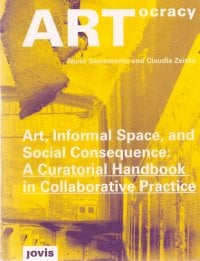‘Artocracy Art, Informal Space, and Social Consequence: A Curatorial Handbook in Collaborative Practice’ by Nuno Sacramento and Claudia Zieske

For over 15 years, something remarkable has been happening in the small Aberdeenshire town of Huntly. There, a small organisation called Deveron Arts has been occupying a space somewhere between a social service, a curatorial arts practice, a town crier and a local branding agency. Working with artists-in-residence, it creates wonderful, collaborative site-specific projects. One, involving bicycles that draw on tarmac, allowed residents to envisage what a car-free Huntly might look like; another helped locals to come to terms with the disappearance of a local cinema; yet another created a pop-up drive-in cinema showing ‘Rebel Without A Cause’ to draw boy racers into a more positive dialogue with older people.
Each project draws on an increasingly wide network of local partners and funders. Each in some way responds to a local need; a project to literally re-brand the town itself began with an approach from the local Development Trust. And each project spins off into its own local debates, meetings or parades. It’s a great example of how art can become part of how a town conceives itself. Out of that experience, two of the organisation’s curator have produced this excellently written handbook for local collaborative practice.
In the current political climate of localism, small agencies like Deveron Arts appear to offer a new way of working. Starting with a social problem, or ‘topic’ as they call it, Huntly’s remarkable artworks are mostly paid for by social agencies of some sort; only 20% comes from arts funding.
Part casebook, part handbook, it contains useful chapters on how to conduct a local cultural audit, how to checklist a marketing campaign, how to reach out to other sectors and more. But if collaborative work holds a real future for artistic practice in these straitened times, this book also demonstrates the limits of this particular approach. As the authors acknowledge, part of the considerable success of ‘the town is the venue’, is in the nature of the venue (see AP209). Huntly has only 4,000 residents and is close to the city of Aberdeen. How much of this could work in a more challenging social environment?
The bigger question is one that all of us working in this new and in many ways exciting collaborative environment have to consider. It’s great that so many agencies are beginning to understand the social value of art, but with that comes the ugly can of worms of instrumentalism. In Huntly they tackle social issues head on with art; a lot of fellow curators and producers might be a little nervous about conceiving artists as people who are there to build the Big Society.
Join the Discussion
You must be logged in to post a comment.